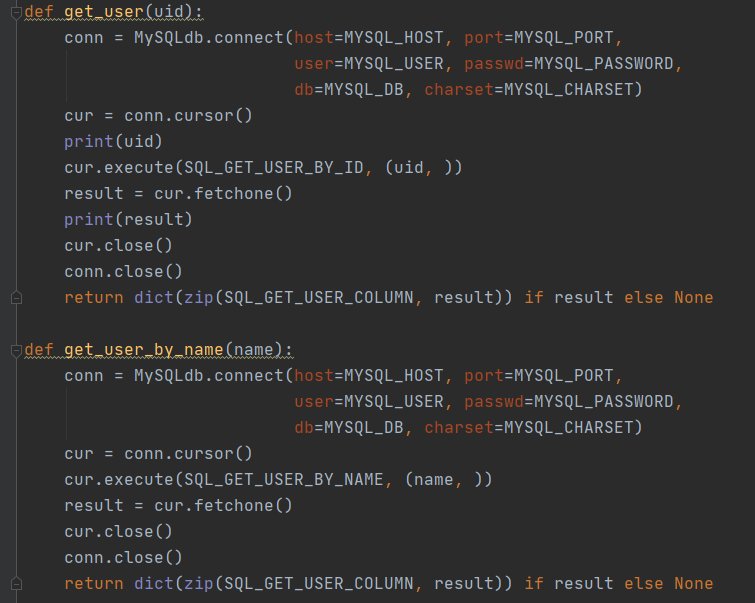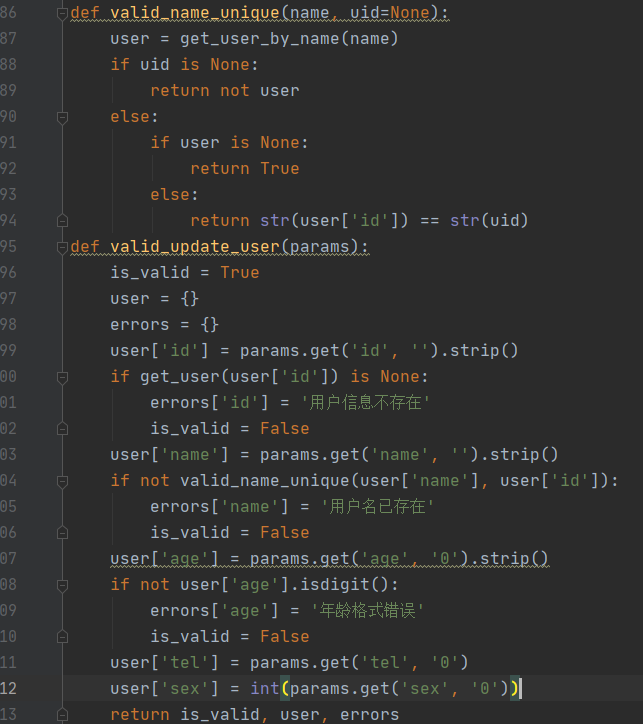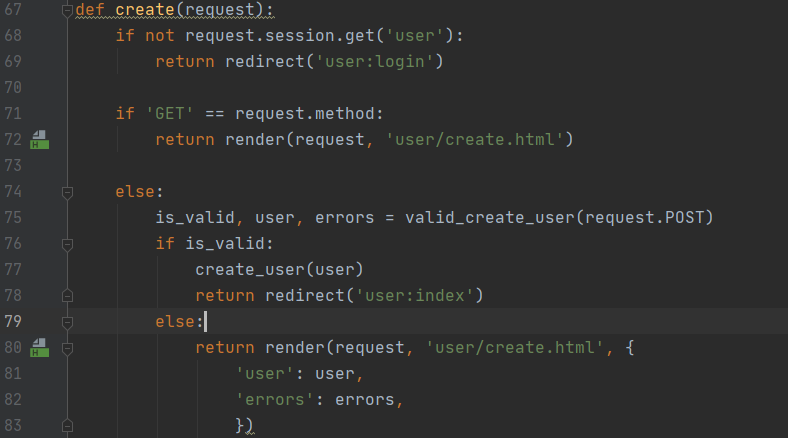Python3项目初始化4-->用户编辑、创建和删除
15、用户编辑
主要是修改model.py部分
SQL_GET_USER_COLUMN = ['id', 'name', 'age', 'tel', 'sex']
SQL_GET_USER_BY_ID = 'SELECT id,name,age,tel,sex FROM user2 where id=%s'
SQL_GET_USER_BY_NAME ='SELECT id,name,age,tel,sex FROM user2 where name=%s'
SQL_UPDATE_USER ='UPDATE user2 SET name=%s,age=%s,sex=%s, tel=%s where id=%s'



浏览器访问编辑,可以正常修改用户名,联系方式,年龄,性别等信息。
16、添加用户
首页index.html设置,
当前登录用户是:{{ request.session.user.name }}, <a href="/user/logout/">退出登录</a>
<a href="{% url 'user:create' %}">创建</a> ===>需要添加的部分
<table border="1" cellspacing="0">
添加url前端create.html展示,
<!DOCTYPE html>
<html>
<head>
<meta charset="utf-8"/>
<title>用户创建</title>
</head>
<body>
<form action="{% url 'user:create' %}" method="POST">
{% if errors %}
{% for key, error in errors.items %}
{{ error }} <br/>
{% endfor %}
{% endif %}
{% csrf_token %}
用户名: <input type="text" name="name" value="{{ user.name }}"/> <br />
密码: <input type="password" name="password" value=""/> <br />
再次输入密码: <input type="password" name="other_password" value=""/> <br />
联系方式: <input type="text" name="tel" value="{{ user.tel }}"/> <br />
年龄: <input type="text" name="age" value="{{ user.age }}"/> <br />
性别: <input type="radio" name="sex" value="1"
{% if user.sex != 0%} checked="checked" {% endif %}
/> 男
<input type="radio" name="sex" value="0"
{% if user.sex == 0%} checked="checked" {% endif %}/> 女 <br />
<input type="submit" value="修改"/> <br />
</form>
</body>
</html>
路由设置,
path('create/', views.create, name='create'),
视图设置:
from .models import valid_login as ... valid_create_user, create_user
def create(request):

主要是修改model.py部分
SQL_UPDATE_USER ='UPDATE user2 SET name=%s,age=%s,sex=%s, tel=%s where id=%s'
SQL_CREATE_USER ='INSERT into user2(name, password, age, tel, sex) values(%s,%s, %s,%s,%s)'
def valid_create_user(params):
is_valid = True
user = {}
errors = {}
users = get_users()
user['name'] = params.get('name', '').strip()
if user['name'] == "":
errors['name'] = '用户信息不存在'
is_valid = False
elif get_user_by_name(user['name']):
is_valid = False
errors['name'] = '用户名重复.'
user['age'] = params.get('age', '0').strip()
if not user['age'].isdigit():
errors['age'] = '年龄格式错误'
is_valid = False
user['tel'] = params.get('tel', '0')
user['sex'] = int(params.get('sex', '0'))
user['password'] = params.get('password', '').strip()
if user['password'] == '' or params.get('other_password') != user["password"]:
is_valid = False
errors['password'] = '密码不能为空, 且两次输入密码必须相同.'
return is_valid, user, errors
def create_user(params):
conn = MySQLdb.connect(host=MYSQL_HOST, port=MYSQL_PORT,
user=MYSQL_USER, passwd=MYSQL_PASSWORD,
db=MYSQL_DB, charset=MYSQL_CHARSET)
cur = conn.cursor()
args = (params['name'], params['password'], params['age'], params['tel'], params['sex'])
cur.execute(SQL_CREATE_USER, args)
conn.commit()
cur.close()
conn.close()
return True
此时页面访问,是可以添加用户的。
16、删除用户
只修改model,其他不变。
SQL_DELETE_USER ='DELETE from user2 where id=%s'
def delete_user(uid):
conn = MySQLdb.connect(host=MYSQL_HOST, port=MYSQL_PORT,
user=MYSQL_USER, passwd=MYSQL_PASSWORD,
db=MYSQL_DB, charset=MYSQL_CHARSET)
cur = conn.cursor()
cur.execute(SQL_DELETE_USER, (uid, ))
conn.commit()
cur.close()
conn.close()
return True
页面操作,可以删除用户。
17、引入dbutils函数改造代码
cat user/dbutils.py 工具类编辑。
#encoding:utf-8
import MySQLdb
import traceback
MYSQL_HOST = '192.168.1.118'
MYSQL_PORT = 3306
MYSQL_USER = 'wang'
MYSQL_PASSWORD = 'Test@123'
MYSQL_DB = 'db_name'
MYSQL_CHARSET = 'utf8'
def execute_sql(sql, args=(), fetch=True, one=False):
cnt, result = 0, None
conn, cur = None, None
try:
conn = MySQLdb.connect(host=MYSQL_HOST, port=MYSQL_PORT,
user=MYSQL_USER, passwd=MYSQL_PASSWORD,
db=MYSQL_DB, charset=MYSQL_CHARSET)
cur = conn.cursor()
cur.execute(sql, args)
if fetch:
result = cur.fetchone() if one else cur.fetchall()
else:
conn.commit()
except BaseException as e:
print(e)
print(traceback.format_exc())
finally:
if cur:
cur.close()
if conn:
conn.close()
return cnt, result
model.py引入工具类。
#enconding: utf-8
from .dbutils import execute_sql
SQL_LOGIN = 'SELECT id,name,password,age,tel,sex FROM user2 where name=%s and password=%s LIMIT 1'
SQL_LIST = 'SELECT id,name,age,tel,sex FROM user2'
SQL_LIST_COLUMN = ['id', 'name', 'age', 'tel', 'sex']
SQL_USER_COLUMN = ['id', 'name', 'age', 'tel', 'sex']
SQL_GET_USER_COLUMN = ['id', 'name', 'age', 'tel', 'sex']
SQL_GET_USER_BY_ID = 'SELECT id,name,age,tel,sex FROM user2 where id=%s'
SQL_GET_USER_BY_NAME ='SELECT id,name,age,tel,sex FROM user2 where name=%s'
SQL_UPDATE_USER ='UPDATE user2 SET name=%s,age=%s,sex=%s, tel=%s where id=%s'
SQL_CREATE_USER ='INSERT into user2(name, password, age, tel, sex) values(%s,%s, %s,%s,%s)'
SQL_DELETE_USER ='DELETE from user2 where id=%s'
def get_users():
cnt, result = execute_sql(SQL_LIST)
return [
dict(zip(SQL_LIST_COLUMN, line))
for line in result
]
def valid_login(name, password):
cnt, result = execute_sql(SQL_LOGIN, (name, password), one=True)
return dict(zip(SQL_USER_COLUMN, result)) if result else None
def delete_user(uid):
execute_sql(SQL_DELETE_USER, (uid, ), fetch=False)
return True
def get_user(uid):
cnt, result = execute_sql(SQL_GET_USER_BY_ID, (uid, ), one=True)
return dict(zip(SQL_GET_USER_COLUMN, result)) if result else None
def get_user_by_name(name):
cnt, result = execute_sql(SQL_GET_USER_BY_NAME, (name,), one=True)
return dict(zip(SQL_GET_USER_COLUMN, result)) if result else None
def valid_name_unique(name, uid=None):
user = get_user_by_name(name)
if uid is None:
return not user
else:
if user is None:
return True
else:
return str(user['id']) == str(uid)
def valid_update_user(params):
is_valid = True
user = {}
errors = {}
user['id'] = params.get('id', '').strip()
if get_user(user['id']) is None:
errors['id'] = '用户信息不存在'
is_valid = False
user['name'] = params.get('name', '').strip()
if not valid_name_unique(user['name'], user['id']):
errors['name'] = '用户名已存在'
is_valid = False
user['age'] = params.get('age', '0').strip()
if not user['age'].isdigit():
errors['age'] = '年龄格式错误'
is_valid = False
user['tel'] = params.get('tel', '0')
user['sex'] = int(params.get('sex', '0'))
return is_valid, user, errors
def update_user(params):
args = (params['name'], params['age'], params['sex'], params['tel'], params['id'])
cnt, result = execute_sql(SQL_UPDATE_USER, args, fetch=False)
return True
def valid_create_user(params):
is_valid = True
user = {}
errors = {}
users = get_users()
user['name'] = params.get('name', '').strip()
if user['name'] == "":
errors['name'] = '用户信息不存在'
is_valid = False
elif get_user_by_name(user['name']):
is_valid = False
errors['name'] = '用户名重复.'
user['age'] = params.get('age', '0').strip()
if not user['age'].isdigit():
errors['age'] = '年龄格式错误'
is_valid = False
user['tel'] = params.get('tel', '0')
user['sex'] = int(params.get('sex', '0'))
user['password'] = params.get('password', '').strip()
if user['password'] == '' or params.get('other_password') != user["password"]:
is_valid = False
errors['password'] = '密码不能为空, 且两次输入密码必须相同.'
return is_valid, user, errors
def create_user(params):
args = (params['name'], params['password'], params['age'], params['tel'], params['sex'])
cnt, result = execute_sql(SQL_CREATE_USER, args, fetch=False)
return True
def delete_user(uid):
execute_sql(SQL_DELETE_USER, (uid, ), fetch=False)
return True
以上验证全部功能ok。




【推荐】国内首个AI IDE,深度理解中文开发场景,立即下载体验Trae
【推荐】编程新体验,更懂你的AI,立即体验豆包MarsCode编程助手
【推荐】抖音旗下AI助手豆包,你的智能百科全书,全免费不限次数
【推荐】轻量又高性能的 SSH 工具 IShell:AI 加持,快人一步
· 25岁的心里话
· 闲置电脑爆改个人服务器(超详细) #公网映射 #Vmware虚拟网络编辑器
· 零经验选手,Compose 一天开发一款小游戏!
· 通过 API 将Deepseek响应流式内容输出到前端
· AI Agent开发,如何调用三方的API Function,是通过提示词来发起调用的吗